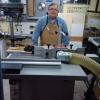Hey everyone, I don't post very often since I can usually find answers searching older threads. However, in this case, I'm not finding much.
I have a small shop. 2 car garage. I need dust collection. My question is, how big and how much? I really only need it for my cabinet table saw and my bandsaw. I would be only hooking up one at a time by moving a flexible hose back and forth between the two. I'm torn between getting the Grizzly 1 HP canister DC and the 2 HP canister DC. Is 1 HP more than enough for dust management on a single piece of equipment? Or should I be safe and get the 2 HP? I don't want to overkill this situation like I usually do, and I don't want to have to leave open ports on the intake because my DC is way overpowered for my needs. Any advise would be very helpful. Thank you.





 Reply With Quote
Reply With Quote





